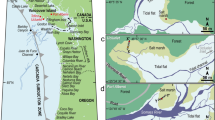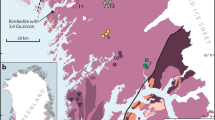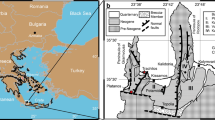Abstract
A detailed knowledge of Himalayan development is important for our wider understanding of several global processes, ranging from models of plateau uplift to changes in oceanic chemistry and climate1,2,3,4. Continental sediments 55 Myr old found in a foreland basin in Pakistan5 are, by more than 20 Myr, the oldest deposits thought to have been eroded from the Himalayan metamorphic mountain belt. This constraint on when erosion began has influenced models of the timing and diachrony of the India–Eurasia collision6,7,8, timing and mechanisms of exhumation9,10 and uplift11, as well as our general understanding of foreland basin dynamics12. But the depositional age of these basin sediments was based on biostratigraphy from four intercalated marl units5. Here we present dates of 257 detrital grains of white mica from this succession, using the 40Ar–39Ar method, and find that the largest concentration of ages are at 36–40 Myr. These dates are incompatible with the biostratigraphy unless the mineral ages have been reset, a possibility that we reject on the basis of a number of lines of evidence. A more detailed mapping of this formation suggests that the marl units are structurally intercalated with the continental sediments and accordingly that biostratigraphy cannot be used to date the clastic succession. The oldest continental foreland basin sediments containing metamorphic detritus eroded from the Himalaya orogeny therefore seem to be at least 15–20 Myr younger than previously believed, and models based on the older age must be re-evaluated.
This is a preview of subscription content, access via your institution
Access options
Subscribe to this journal
Receive 51 print issues and online access
$199.00 per year
only $3.90 per issue
Buy this article
- Purchase on Springer Link
- Instant access to full article PDF
Prices may be subject to local taxes which are calculated during checkout



Similar content being viewed by others
References
Ruddiman, W. F. & Kutzbach, J. E. Plateau uplift and climate change. Sci. Am. 264, 42–50 (1991).
Krishnaswami, S., Trivedi, J. R., Sarin, M., Ramesh, R. & Sharma, K. Strontium isotopes and rubidium in the Ganga–Bramaputra rivers system: Weathering in the Himalaya, fluxes to the Bay of Bengal and contributions to the evolution of oceanic 87Sr/86Sr. Earth Planet. Sci. Lett. 109, 2443–253 (1992).
Richter, F. M., Rowley, D. B. & DePaolo, D. J. Sr isotopic evolution of seawater: the role of tectonics. Earth Planet. Sci. Lett. 109, 11–23 (1992).
Houseman, G. & England, P. Crustal thickening versus lateral expulsion in the Indian–Asian continental collision. J. Geophys. Res. 98, 12233–12249 (1993).
Bossart, P. & Ottiger, R. Rocks of the Murree Formation in Northern Pakistan: indicators of a descending foreland basin of late Palaeocene to middle Eocene age. Eclogae Geol. Helv. 82, 133–165 (1989).
Rowley, D. B. Age of initiation of collision between India and Eurasia: A review of stratigraphic data. Earth Planet. Sci. Lett. 145, 1–13 (1996).
Rowley, D. B. Minimum age of initiation of collision between India and Eurasia north of Everest based on the subsidence history of the Zhepure mountain section. J. Geol. 106, 229–235 (1998).
Uddin, A. & Lundberg, N. Cenozoic history of the Himalayan–Bengal system: Sand composition in the Bengal Basin, Bangladesh. Geol. Soc. Am. Bull. 110, 497–511 (1998).
Treloar, P. J., Rex, D. C. & Williams, M. P. The role of erosion and extension in unroofing the Indian Plate thrust stack, Pakistan Himalaya. Geol. Mag. 128, 465–478 (1991).
Treloar, P. J. Exhumation of high-grade Indian Plate rocks in North Pakistan: Mechanical implications of a multi-phase process. Terra Nostra 2, 157–158 (1999).
Critelli, S. & Garzanti, E. Provenance of the Lower Tertiary Murree redbeds (Hazara–Kashmir Syntaxis, Pakistan) and initial rising of the Himalayas. Sedim. Geol. 89, 265–284 (1994).
Burbank, D. W., Beck, R. A. & Mulder, T. The Himalayan foreland basin. In The Tectonic Evolution of Asia (eds Yin, A. & Harrison, T. M.) 149–188 (Cambridge Univ. Press, 1996).
Najman, Y. M. R., Pringle, M. S., Johnson, M. R. W., Robertson, A. H. F. & Wijbrans, J. R. Laser 40Ar/39Ar dating of single detrital muscovite grains from early foreland basin sediments in India: Implications for early Himalayan evolution. Geology 25, 535–538 (1997).
Pivnik, D. A. & Wells, N. A. The transition from Tethys to the Himalaya as recorded in northwest Pakistan. Geol. Soc. Am. Bull. 108, 1295–1313 (1996).
Clauer, N. & Chaudri, S. Isotopic dating of very low-grade metasedimentary and metavolcanic rocks: techniques and methods. In Low Grade Metamorphism (eds Frey, M. & Robinson, D.) 202–226 (Blackwell Science, 1999).
Bossart, P. Eine Neuinterpretation der Tektonik der Hazara Kashmir Syntaxis (Pakistan). Thesis, ETH Zurich, Switzerland (1986).
Kubler, B. La cristallinité de l'illite à les zones tout a fait supérieures du metamorphismé. In Étages Tectoniques 105–122. (A la Baconniere, Neuchatel, Switzerland, 1967).
Blenkinsop, T. G. Definition of low-grade metamorphic zones using illite crystallinity. J. Met. Petrol. 6, 623–636 (1988).
Weber, K. Notes on the determination of illite crystallinity. Neues Jb. Miner. Monatshefte 6, 267–276 (1972).
Butler, R. When did India hit Asia? Nature 373, 20–21 (1995).
Garzanti, E., Baud, A & Mascle, G. Sedimentary record of the northward flight of India and its collision with Eurasia (Ladakh Himalaya, India). Geodinim. Acta 1, 297–312 (1987).
Garzanti, E., Critelli, S & Ingersoll, R. V. Paleogeographic and paleotectonic evolution of the Himalayan range as reflected by detrital modes of Tertiary sandstones and modern sands (Indus transects, India and Pakistan). Geol. Soc. Am. Bull. 108, 631–642 (1996).
DeCelles, P. G., Gehrels, G. E., Quade, J. & Ojha, T. P. Eocene–early Miocene foreland basin development and the history of Himalayan thrusting, western and central Nepal. Tectonics 17, 741–765 (1998).
Richards, J. P., Noble, S. R. & Pringle, M. S. A revised Late Eocene age for porphyry Cu magmatism in the Escondida Area, Northern Chile. Econ. Geol. 94, 1231–1248 (1999).
Acknowledgements
We thank E. Laws for field assistance, I. Hussain and Banares for driving, and Major Saeed for his co-operation during major road building; R. Marr, J. Nicholls and M. Stout for assistance with the electron probe analyses; B. Davidson and J. Imlach for assistance with the Ar-Ar analyses; A. Calder for performing the illite crystallinity analyses; N. Portelance for drafting some of the figures; and D. Burbank and P. Copeland for critical reviews. This work was funded by a Royal Society Dorothy Hodgkin Fellowship and completed during a Royal Society International Fellowship to Y.N. Additional support was provided by the Fold–Fault Research Project at the University of Calgary and a Royal Society Research Grant to Y.N. Ar–Ar analyses were funded by NERC support of the Argon Isotope Facility at the Scottish Universities Environmental Research Centre (SUERC).
Author information
Authors and Affiliations
Rights and permissions
About this article
Cite this article
Najman, Y., Pringle, M., Godin, L. et al. Dating of the oldest continental sediments from the Himalayan foreland basin. Nature 410, 194–197 (2001). https://doi.org/10.1038/35065577
Received:
Accepted:
Issue Date:
DOI: https://doi.org/10.1038/35065577
This article is cited by
-
Paleogene integrative stratigraphy, biotas, and paleogeographical evolution of the Qinghai-Tibetan Plateau and its surrounding areas
Science China Earth Sciences (2024)
-
Foreland basin unconformity, Western Himalaya, Pakistan: timing gap, regional correlation and tectonic implications
Progress in Earth and Planetary Science (2023)
-
Cenozoic sedimentary records of climate-tectonic coupling in the Western Himalaya
Progress in Earth and Planetary Science (2017)
-
Processes of initial collision and suturing between India and Asia
Science China Earth Sciences (2017)
-
Structural features and proto-type basin reconstructions of the Bay of Bengal Basin: A remnant ocean basin model
Journal of Earth Science (2017)
Comments
By submitting a comment you agree to abide by our Terms and Community Guidelines. If you find something abusive or that does not comply with our terms or guidelines please flag it as inappropriate.



